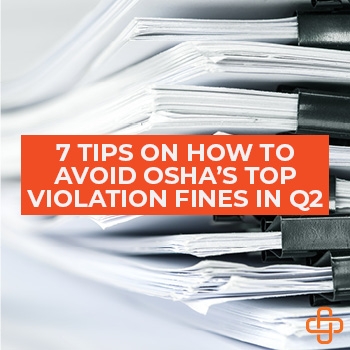 As you may have noticed, OSHA was extremely active in the first quarter of 2019 inspecting job sites and doling out fines to construction companies that subjected their workers to hazards and as we soon found out, it doesn’t appear they have any plans of slowing down!
As you may have noticed, OSHA was extremely active in the first quarter of 2019 inspecting job sites and doling out fines to construction companies that subjected their workers to hazards and as we soon found out, it doesn’t appear they have any plans of slowing down!
Labor Secretary Alexander Acosta advised the House appropriations committee that there are 76 additional OSHA inspectors in training and would soon be headed out into the field.
In the first 3 months of 2019, the largest fine came from an OSHA-approved state plan administered by the Virginia Department of Labor and Industry under its Virginia Occupational Safety and Health (VOSH) program.
There are currently 22 state plans covering both public and private workers and six state plans that cover public employees only. State plans must have standards that are at least as effective as federal ones, and that are on par with the agency’s monetary penalties.
OSHA penalties increased at the beginning of this year to now reflect:
- $13,260 per violation for serious, other-than-serious and posting requirement violations;
- $13,260 per day for failure to abate violations;
- $132,598 per violation for willful or repeated violations.
Falls played a prominent role in this quarter’s list of violations, affirming that the agency is still focused on eliminating the hazards that pose the most danger to construction workers. Another one of OSHA’s “Fatal Four” hazards, those involving electrical injuries, took the top spot.
So, what can you do to avoid Q2 fines? You guessed it, start with education – like toolbox talks!
Tips for Delivering Effective Toolbox Talks
1. Get Creative With Toolbox Topics
Getting your employees to stay safe is all about engagement. To enhance their engagement, you’ve got to play into the topics that make sense to them. Think of toolbox talks as ‘employee targeting’ and stick to those topics that will bring value to their job, asap!
Here are some topics you can use for your next talk:
2. Cover Seasonal Issues
During the winter months, design talks around winter driving tips, danger working near ice and snow, or hypothermia prevention. During the summer season, design your toolbox talks around fireworks safety, reporting heat stress injuries or how to stay properly hydrated while working outdoors.
3. Discuss Common Injuries
Common injuries like back, neck, knee or ankle falls can be prevented when proper measures are taken. Offer valuable (even life-saving!) advice for simple movement techniques your workers can implement to avoid injury.
4. Highlight Industry-Relevant Topics
Design your talks so they are short and to-the-point, and applicable to your employees. If you’re in the construction field, choose forklift and other construction equipment topics. If your employees have to lift heavy supplies daily, choose a proper lifting/ergonomics topic.
Get creative and relevant to keep your workers healthy, fit and happy!
5. Get Personal
If you miss the mark with your talk, you’ll lose your audience.
The best way to grab their attention?
By getting personal.
Start your talk with a personal story of when you were injured because you failed to practice safety as you should. Or, ask an employee who has been injured to come up and tell the group his/her story.
Nothing creates a shock-and-awe to grab worker’s attention than a personal story of their peers. Remember, there’s power in the impact: if it can happen to someone they work with, it can happen to them.
6. Make it Interactive
Do you regularly give talks on how to stay safe and wonder why your employees look like a deer caught in headlights? If you aren’t hooking their interest with engagement, they’ll think about their weekend plans instead of focusing on you.
Get interactive to keep their attention.
Instead of starting your talk with, “Trips and falls are dangerous because…etc., etc., etc…” teach your employees how to scan their work area for possible obstructions that lead to slip and falls. Show them in a live demonstration by asking for assistance from 1, 2, or 3 workers.
Ask them questions throughout your talk, like: “Who can guess what the number one cause of slip and falls is (and I’ll give you a hint, it’s not a slippery surface.”)
Quiz them as a group: “What’s the first thing you should do when you get a chemical burn?” and offer a small prize for whoever answers correctly.
Promote greater interaction and teamwork by ending the talk with a pow-wow: Divide them in small groups where they get to brainstorm a new and improved way to stay safe in their fast-paced environment and share with everyone.
7. Watch Your Tone
Your tone will communicate one of two things: you’re bored and disengaged yourself (which will make them detach from the conversation too), or you’re a safety expert. The more of an expert you sound, the more your employees will perk up—because you are providing something of value!
Speak with enthusiasm.
As you talk, make sure you are moving around the office so you can observe who is raising their hand and participating, and who is trying to blend into the background. Watch your worker’s body language, and that will help clue you into how to engage your group at large.

Holly is an ER nurse by trade, but loves content marketing. She was born outside the box and believes everything is better with “sprinkles and sparkles”. She is passionate about impacting lives and uses marketing as her platform for sharing practical solutions to address real life occupational health challenges.
Find out more about our Injury Case Management services or our Occupational Health Programs.










